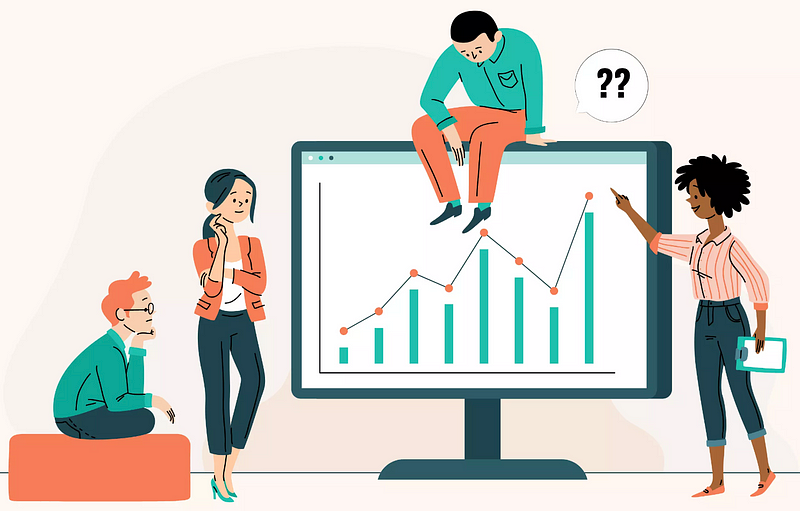Mastering Sales Analysis with R: A Comprehensive Guide
Written on
Chapter 1: Introduction to Sales Performance Analysis
Understanding sales performance is vital for any organization seeking growth. By examining sales data, companies can make strategic decisions and improve their operations. This guide will take you through the process of analyzing sales performance with R, including a concealed analysis step to determine sales growth rates.

Prerequisites
Before we dive in, ensure that you have R and RStudio set up on your machine. You will also need to install the following R packages:
install.packages(c("tidyverse", "lubridate"))
Step 1: Import Required Libraries
Let’s begin by loading the necessary libraries for data manipulation and analysis.
# Load necessary libraries
library(tidyverse)
library(lubridate)
Step 2: Generate a Sample Dataset
In this tutorial, we will be using a sample dataset representing monthly sales figures.
# Sample dataset: Monthly sales data
sales_data <- tibble(
month = seq(ymd('2022-01-01'), ymd('2022-12-01'), by = 'month'),
sales = c(12000, 15000, 17000, 16000, 18000, 22000, 21000, 23000, 25000, 27000, 26000, 28000)
)
Step 3: Visualize the Sales Data
Next, we will create a visualization of the sales data to identify trends.
# Plot the sales data
sales_data %>%
ggplot(aes(x = month, y = sales)) +
geom_line(color = 'blue') +
geom_point(color = 'red') +
labs(title = "Monthly Sales Data",
x = "Month",
y = "Sales (in USD)")
Step 4: Calculate Monthly Sales Growth
Now, we will compute the month-over-month sales growth.
# Calculate monthly sales growth
sales_data <- sales_data %>%
mutate(sales_growth = (sales - lag(sales)) / lag(sales) * 100)
Step 5: Concealed Analysis
In this step, we will calculate the average sales growth rate using a function that obscures the analysis.
# Hidden analysis: Calculate average sales growth rate
calculate_average_growth <- function(df) {
avg_growth <- df %>%
summarize(average_growth = mean(sales_growth, na.rm = TRUE))return(avg_growth)
}
# Invoke the hidden analysis function
average_growth <- calculate_average_growth(sales_data)
Step 6: Display the Results
Let’s print the sales data alongside the growth and average growth rates.
# Print the results
print(sales_data)
print(average_growth)
Step 7: Visualize Sales Growth Rates
Finally, we’ll visualize the sales growth rates using a bar chart.
# Visualize sales growth rates
sales_data %>%
ggplot(aes(x = month, y = sales_growth, fill = sales_growth > 0)) +
geom_col(show.legend = FALSE) +
labs(title = "Monthly Sales Growth Rates",
x = "Month",
y = "Growth Rate (%)")
Conclusion
Congratulations! You have successfully analyzed sales performance data using R. This guide provided the essential steps, including a concealed analysis to enhance your understanding. Keep exploring and advancing your analytical skills!
Full Code Reference
Here’s the complete code for your convenience:
# Load necessary libraries
library(tidyverse)
library(lubridate)
# Sample dataset: Monthly sales data
sales_data <- tibble(
month = seq(ymd('2022-01-01'), ymd('2022-12-01'), by = 'month'),
sales = c(12000, 15000, 17000, 16000, 18000, 22000, 21000, 23000, 25000, 27000, 26000, 28000)
)
# Plot the sales data
sales_data %>%
ggplot(aes(x = month, y = sales)) +
geom_line(color = 'blue') +
geom_point(color = 'red') +
labs(title = "Monthly Sales Data",
x = "Month",
y = "Sales (in USD)")
# Calculate monthly sales growth
sales_data <- sales_data %>%
mutate(sales_growth = (sales - lag(sales)) / lag(sales) * 100)
# Hidden analysis: Calculate average sales growth rate
calculate_average_growth <- function(df) {
avg_growth <- df %>%
summarize(average_growth = mean(sales_growth, na.rm = TRUE))return(avg_growth)
}
# Invoke the hidden analysis function
average_growth <- calculate_average_growth(sales_data)
# Print the results
print(sales_data)
print(average_growth)
# Visualize sales growth rates
sales_data %>%
ggplot(aes(x = month, y = sales_growth, fill = sales_growth > 0)) +
geom_col(show.legend = FALSE) +
labs(title = "Monthly Sales Growth Rates",
x = "Month",
y = "Growth Rate (%)")
Community Engagement
Join our vibrant community on Discord to connect with passionate writers who are eager to support each other.

Additionally, my experience in the Medium community has been incredibly rewarding. With over 40 members, each excelling in their fields, I have received invaluable feedback and encouragement, which has significantly contributed to my growth as a writer.
Chapter 2: Practical Video Guides
The first video titled "Analyze Home Sales Price Data Using R" provides a thorough walkthrough on how to leverage R for analyzing home sales data effectively.
The second video, "Analyze Your Sales Data to Sell Better," offers practical strategies to optimize sales performance through data analysis techniques.